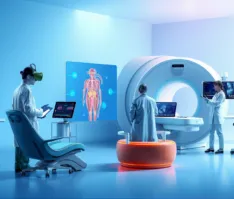Table of Contents
Electronic health records (EHRs) are digital tools that store and manage the health information of patients. EHR Optimization can improve healthcare delivery and patient care by facilitating data access, communication, coordination, and decision-making among various healthcare providers.
However, EHRs can also pose challenges and frustrations for users, such as increased documentation time, reduced face-to-face interaction, and system errors. Therefore, EHR optimization is essential to ensure that EHRs are used effectively and efficiently to support clinical workflows and patient outcomes.
EHR optimization is the process of enhancing the functionality, usability, and performance of EHR systems to meet the changing needs and expectations of users and organizations. EHR optimization can help streamline workflow, reduce errors, improve data quality, increase user satisfaction, and enhance interoperability and integration with other systems.
In this article, we will outline the key steps to EHR optimization for enhancing patient care and workflow efficiency.
7 Key Steps to EHR Optimization

1. Understanding the Current EHR System
The first step to EHR optimization is to evaluate the existing EHR system and identify areas for improvement. This involves analyzing the current workflows and processes that involve EHR usage and determining the pain points and inefficiencies that users face. For example, some common issues that users may encounter are:
- Data entry is cumbersome and time-consuming
- Data retrieval is difficult and slow
- Data is inaccurate, incomplete, or inconsistent
- Data is not standardized or structured
- Data is not shared or exchanged with other systems
- The system is not user-friendly or intuitive
- The system is not updated or maintained regularly
- The system does not support clinical decision-making or quality improvement
To understand the current EHR system, it is important to collect data and feedback from various sources, such as user surveys, interviews, observations, focus groups, and system reports. The data and feedback should be analyzed and synthesized to identify the root causes of the problems and the gaps between the current and desired states of the EHR system.
2. Setting Goals for EHR Optimization
The second step to EHR optimization is to define clear goals and objectives for the optimization process. The goals and objectives should align with the organization’s strategic objectives and vision, and reflect the needs and expectations of the users and stakeholders. Setting goals helps guide the optimization process and measure its progress and outcomes.
Some examples of common goals for EHR optimization are:
- Improve data accuracy, completeness, and consistency
- Reduce documentation time and burden
- Enhance data access and retrieval
- Enhance data analysis and reporting
- Enhance interoperability and integration with other systems
- Enhance user satisfaction and engagement
- Enhance patient safety and quality of care
- Enhance patient satisfaction and experience
The goals and objectives should be specific, measurable, achievable, relevant, and time-bound (SMART). They should also be prioritised and classified based on their significance and urgency. The goals and objectives should be communicated and agreed upon by all the users and stakeholders involved in the optimization process.
3. Involving Key Stakeholders
The third step to EHR optimization is to involve key stakeholders, including clinicians, IT professionals, administrators, and nurses, in the optimization process. Stakeholders are the people who are affected by or have an interest in the EHR system and its optimization.
Involving stakeholders is crucial for ensuring that the optimization process is collaborative, inclusive, and responsive to the needs and preferences of the users and the organization.
Stakeholders can contribute to the optimization process in various ways, such as:
- Providing input and feedback on the current and desired states of the EHR system
- Identifying and prioritizing the problems and solutions for EHR optimization
- Participating in the design and testing of the optimized EHR system
- Providing training and support for the users of the optimized EHR system
- Advocating and promoting the adoption and use of the optimized EHR system
To involve stakeholders effectively, it is important to establish clear roles and responsibilities and to create a culture of trust and transparency. It is also important to provide regular communication and updates and to solicit and address feedback and concerns. Moreover, it is important to provide incentives and recognition for the stakeholders who participate and contribute to the optimization process.
4. Redesigning Workflows and Processes
The fourth step to EHR optimization is to reevaluate and redesign workflows and processes to align with optimized EHR usage. Workflows and processes are the sequences of tasks and activities that users perform to accomplish a specific goal or outcome. EHR optimization systems can help streamline workflows and processes, reduce manual data entry, and automate repetitive tasks.
Some examples of workflow and process redesigns that can enhance patient care and improve overall efficiency are:
- Developing templates and macros for commonly encountered documentation scenarios
- Data entry using voice recognition and natural language processing
- Using clinical decision support and alerts to validate data and improve quality
- Data visualization and dashboards are used for data analysis and reporting.
- For data sharing and exchange, application programming interfaces (APIs) and health information exchange (HIE) are used.
- Using patient portals and mobile devices to engage and educate patients
To redesign workflows and processes, it is important to map out the current and desired workflows and processes and to identify the gaps and opportunities for improvement. It is also important to test and evaluate the redesigned workflows and processes and to monitor and measure their impact and outcomes.
5. Training and Education
The fifth step to EHR optimization is to provide comprehensive training programs for all users of the optimized EHR system. Training and education are essential for ensuring that users are familiar and comfortable with the features and functions of the optimized EHR system and that they can use it effectively and efficiently to support their workflows and processes.
Training and education can also help users overcome resistance and increase adoption and satisfaction with the EHR optimization system.
Training and education should be tailored to the needs and preferences of different user groups, such as clinicians, IT professionals, administrators, and nurses. Training and education should also be ongoing and adaptive to the system updates and changes.
Some tips for designing effective training programs are:
- Providing hands-on training and simulations
- Training materials and resources that are personalized and interactive
- Giving feedback and reinforcing
- Offering peer-to-peer and mentorship assistance
- Making online and on-demand access available
6. Enhancing Interoperability and Integration
Enhancing interoperability and integration with other systems is the sixth step in EHR optimization. Interoperability and integration refer to the ability of various systems to exchange and use data in a seamless and secure manner. Improving interoperability and integration can aid in the optimization of EHR systems by facilitating data access, communication, coordination, and decision-making among different healthcare providers and organizations.
Some strategies to improve interoperability and integration with other systems are:
- Adopting and implementing common standards and protocols for data exchange, such as Fast Healthcare Interoperability Resources (FHIR) and Health Level Seven (HL7)
- Establishing and maintaining secure and reliable network connections and interfaces
- Developing and using APIs and HIEs to enable data exchange and integration
- Leveraging cloud computing and artificial intelligence to enable data storage and processing
- Ensuring data privacy and security by complying with relevant regulations and policies, such as the Health Insurance Portability and Accountability Act (HIPAA) and the General Data Protection Regulation (GDPR)
Some benefits of data exchange and seamless integration for patient care and workflow efficiency are:
- Improving data quality and accuracy
- Reducing data duplication and redundancy
- Enhancing data analysis and reporting
- Enhancing clinical decision support and quality improvement
- Enhancing care coordination and collaboration
- Enhancing patient engagement and empowerment
7. Quality Assurance and Continuous Improvement
The seventh and final step in EHR optimisation is to ensure that the optimised EHR system continues to meet the organization’s goals and objectives through ongoing monitoring and quality assurance. The process of verifying and validating that the optimised EHR system meets the predefined standards and specifications is known as quality assurance.
Continuous improvement is the process of identifying and implementing further enhancements and refinements to the optimized EHR system.
Some methods and tools for quality assurance and continuous improvement are:
- Collecting and analyzing user feedback, system performance data, and quality indicators
- Conducting regular audits and reviews to assess the compliance and effectiveness of the optimized EHR system
- Identifying and resolving issues and errors in a timely and proactive manner
- Implementing a continuous improvement process, such as Plan-Do-Check-Act (PDCA) or Six Sigma
- Engaging and empowering users to participate and contribute to the optimization process
What are some common challenges of using EHR systems?

The following are some of the most common issues that arise when using EHR systems:
- System complexity: EHR systems can be complex and difficult to use, particularly for users who are unfamiliar or uncomfortable with technology. EHR systems may also include various features and functions that necessitate training and adaptation. User satisfaction, productivity, and performance can all be impacted by system complexity.
- Cost implications: Implementing and maintaining EHR systems can be costly, particularly for small and rural practices. Hardware, software, licensing, training, support, and upgrades may all be included in the cost of EHR systems. The cost implications of EHR adoption can have an impact on its feasibility and sustainability.
- Resistance to change: Users who are accustomed to their current workflows and processes may be resistant to change when it comes to EHR systems. EHR systems may also be perceived as a threat to users’ autonomy, privacy, or professional identity. Change resistance can have an impact on user acceptance, adoption, and engagement.
- Workflow disruptions: EHR systems have the potential to disrupt users’ existing workflows and processes, particularly during the initial implementation and transition period. Users may need to adjust to new methods of data entry, retrieval, and exchange, as well as new clinical decision support and quality improvement tools. Workflow interruptions can have an impact on user efficiency, effectiveness, and satisfaction.
- Data migration: Data migration from legacy systems or paper records to EHR systems can be difficult. Data conversion, mapping, validation, and cleaning may all be involved in data migration. Data migration has the potential to impact data quality, accuracy, and completeness.
- Interoperability issues: Interoperability issues with other systems, such as lab interfaces, imaging systems, pharmacy systems, and health information exchanges, can occur with EHR systems. Data standards, protocols, formats, and security may all be involved in interoperability issues. Data access, exchange, and integration can all be hampered by interoperability issues.
- Potential breaches of data security and privacy: EHR systems can increase the likelihood of data breaches, theft, or misuse, particularly if they are not properly secured or protected. Data breaches can jeopardize the confidentiality, integrity, and availability of patient data, as well as the users’ and organisations’ trust and reputation. Potential data security and privacy breaches can have an impact on data compliance, ethics, and liability.
Conclusion
EHR optimization is a vital process for enhancing patient care and workflow efficiency. EHR optimization involves understanding the current EHR system, setting goals and objectives, involving key stakeholders, redesigning workflows and processes, providing training and education, enhancing interoperability and integration, and ensuring quality assurance and continuous improvement.
By following these key steps, healthcare organizations can optimize their EHR systems to improve healthcare delivery and overall patient experience.
We are a cloud-based platform that uses artificial intelligence and machine learning to optimize your EHR system. It boosts data quality, interoperability, workflow efficiency, and user satisfaction. We also securely and seamlessly migrate your data from legacy systems or paper records to the cloud. Transform your EHR system and healthcare delivery by contacting us today.





